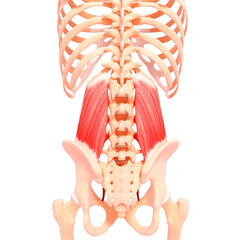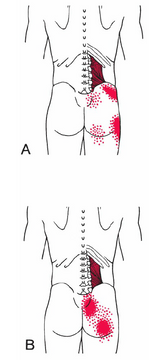The Quadratus Lumborum (QL) is a deep lower back muscle known to refer a ton of pain to the low back when tight [1]. In a nutshell, the QL muscle holds the lower spine upright and wreaks havoc when it is tight and weak. QL muscle pain can affect nearly everyone - active and sedentary individuals for different reasons - with the same result of nagging, aching, and confusing lower back pain.

Quadratus Lumborum (QL) Muscle
QL Muscle Pain in Active Folks
The QL muscle is essential for a healthy lower back and performance in high-impact activities. The QL helps stabilize the spine, which is obviously crucial in sports. Quadratus Lumborum keeps the spine neutral and sturdy when carrying an uneven load, side bending, and performing athletic movements. Athletes in football, basketball, and hockey likely have very strong QL muscles.
QL muscle pain can arise when the stress placed on the QL exceeds its capacity, and it is forced to lock up or spasm to protect the spine from injury. This can happen when an athlete lifts too much, cuts too quickly, or trains longer than their QL has stamina.

QL Muscle Pain Pattern [1]
A QL muscle injury in athletes results in a tensed, painful, spasmed QL. A spasmed Quadratus Lumborum is a great short-term solution to spinal cord injury prevention - because it protects your vertebrae from breaking - but it is very annoying in the weeks post-spasm when the QL is still tight and causing pain.
QL Muscle Pain in Sedentary Folks
The QL muscle pain mechanism is different but equally painful in sedentary folks. In the absence of perfect posture, the QL muscles are taxed constantly when we sit in chairs. This happens because the lower back tends to round when sitting - which stretches and places unnatural pressure on the QL muscles.

Just like in the active QL muscle pain example, at some point, the stress on the QL and lower back is greater than what the muscles can take. The Quadratus Lumborum can tense up or develop trigger points to increase the tension on the muscle and prevent spinal cord injury. Once again this is a nice short-term solution to prevent spinal injury, but it is painful and constricting long term.
Additional QL Muscle Pain Triggers
- Sitting with your wallet in your back pocket - create a QL muscle imbalance where one side is tighter than the other
- Carrying uneven loads like chairs, boxes, and suitcases - Quadratus Lumborum works its hardest during these feats
- Lifting an object outside your capacity - see Lower Back Pain From Lifting
- Sitting for years with poor posture - see "QL Muscle Pain In Sedentary Folks" above
- Playing a high-impact sport you are not conditioned for - see "QL Muscle Pain In Active Folks" above
QL Muscle Pain Relief
There are 3 components to QL muscle pain relief - and it can be much easier than you think. If you are experiencing QL pain yourself, try the following steps to find relief from an angry QL for good.
1. Release - Targeted massage therapy is the best first line of defense against QL muscle pain and tightness. If done correctly, this will break up tons of lower back trigger points and tightness that contribute to your QL muscle pain. For Quadratus Lumborum muscle release, there is no better tool to use than the QL release device QL Claw. QL Claw was designed to release the 5 muscles that contribute to low back pain, and Quadratus Lumborum is first on the list.
2. Stretch - After effective massage and release, the body will be a lot more open and able to perform a QL stretch. This is due to QL trigger points and tightness maintaining constant tension on the muscles, making stretch difficult and restricted. Once tension is removed with massage, stretching can provide an increased range of motion and mobility for a short QL.
3. Strengthen - After your QL muscle pain is relieved and you are feeling nice and loose, you will want to strengthen the muscle to prevent falling back into injury in the future. A few easy QL strengthening exercises are suitcase carries, side planks, and side bends.
QL Muscle Pain Prevention
After releasing trigger points and tightness in the QL muscle, we want to strengthen the muscle to prevent further injury in the future. It is important to release trigger points and tightness first because the constant muscle tension will not go away from strengthening alone.
A few strength exercises for building a bulletproof QL muscle are side planks, suitcase carries (one arm farmers carries), and side hyperextensions. Check out the strengthening portion in the video above for a side plank tutorial inspired by the back doctor Stuart McGill himself. Stuart McGill's side plank variation is awesome for building Quadratus Lumborum strength and endurance. Endurance is key in sports because we want our QL muscles to be strong and stable from start to finish, not just for one heavy movement.
Your QL muscle pain relief journey begins with QL Claw, check it out at the link below!
[1] Donnelly, Joseph M. Travell, Simons & Simons Myofascial Pain and Dysfunction: the Trigger Point Manual. 3rd ed., Wolters Kluwer Health, 2019.
[2] Davies, Clair, and Amber Davies. The Trigger Point Therapy Workbook: Your Self-Treatment Guide for Pain Relief. 3rd ed., New Harbinger Publications, Inc., 2013.


